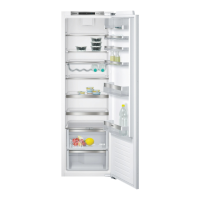en Cleaning and servicing
20
Unplug the appliance from the
mains or switch off the circuit
breaker in the fuse box.
3. Take out all of the food and store it
in a cool place.
Place ice packs (if available) onto
the food.
4. If there is a layer of hoarfrost, allow
this to defrost.
5. Remove all fittings and accessor-
ies from the appliance.
→Page20
6.
Remove the partition. →Page22
7.
Remove the cover. →Page22
8. Remove the telescopic rails.
→Page22
14.2 Cleaning the appliance
WARNING
Risk of electric shock!
An ingress of moisture can cause an
electric shock.
▶ Do not use steam- or high-pres-
sure cleaners to clean the appli-
ance.
Liquid in the lighting or in the con-
trols can be dangerous.
▶ The rinsing water must not drip
into the lighting or controls.
ATTENTION!
Unsuitable cleaning products may
damage the surfaces of the appli-
ance.
▶ Do not use hard scouring pads or
cleaning sponges.
▶ Do not use harsh or abrasive de-
tergents.
▶ Do not use cleaning products with
a high alcohol content.
If you clean fittings and accessories
in the dishwasher, this may cause
them to become deformed or discol-
our.
▶ Never clean fittings and accessory
in the dishwasher.
1. Prepare the appliance for cleaning.
→Page19
2. Clean the appliance, the fittings,
the accessories, the components
and the door seals with a dish
cloth, lukewarm water and a little
pH-neutral washing-up liquid.
3. Dry thoroughly with a soft, dry
cloth.
4. Insert the fittings and install the ap-
pliance components.
5. Electrically connect the appliance.
→Page11
6. Switch on the appliance.
→Page15
7. Putting the food into the appliance.
14.3 Removing the fittings
If you want to clean the fittings thor-
oughly, remove these from your ap-
pliance.
Removing the shelf
▶ Pull out and remove the shelf.

